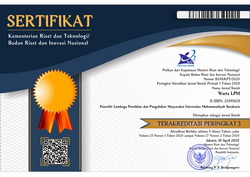Analysis of The Use of Waste Diesel Oil As an Asbuton Modifier in Hot Mix Cold Laid of Porous Asphalt of Pavement Cantabro Value
Keywords:
Asbuton, Porous Asphalt, Hot Mix Cold Laid, Waste Oil, REAMAbstract
The use of petroleum asphalt as a binder still dominates the implementation of road surfacing in Indonesia. Its limited availability and relatively high prices are a problem for the construction industry. Besides petroleum asphalt, Asbuton can also be used as an alternative to the binder in the asphalt mix. Asbuton abundant deposit makes it easier to obtain it at a lower price than petroleum asphalt. However, its use requires a rejuvenating agent to separate the minerals and bitumen and maximize mixing when cold. This study aims to analyze the wear of a hot and cold asphalt mix using rejuvenating agents with variations of 0%, 2%, 3% and 4%, with Asbuton percentages of 5%, 5.5% and 6% with the specifications of the Association of Road Engineers of Malaysia. Laboratory scale. Porous asphalt is intended for light traffic. Wear test of the object to be tested using the Cantabro test. Cantabro test results show that the Porous asphalt mix using waste diesel oil as a rejuvenating agent for Asbuton at the composition of Asbuton 6% + 4% diesel oil waste is the optimal composition. Based on the results of the Cantabro test, it was found that the average wear rate of 0.53% met the REAM specification standards, i.e. wear value ? 20%. So the use of diesel with a variation of 4% and Asbuton 6% can be used in porous asphalt mixtures as it contributes to the surface resistance of the road wear layer. Further research needs to be done using the collision variations, assuming that a porous asphalt mix can be used in heavy traffic.
References
Alamsyah, A. A., & Meiyanto, H. E. (2016). Pemanfaatan Olie Bekas Sebagai Modifier Pada Lapisan Aspal Buton Beragregat ( Lasbutag ). 1–18.
Alamsyah, A. A., & Sampel, P. (2003). Lasbutag Campuran Dingin Untuk Perkerasan. 1.
Cabrera, J. . (2017). Performance of Bituminous and Hydraulic Materials in Pavements. In Performance of Bituminous and Hydraulic Materials in Pavements. https://doi.org/10.1201/9780203743928
Chavanpatil, G. N., & Chokakkar, S. S. (2018). The Study of Porous Asphalt Pavement with Emphasis in Road Construction Design. 623–627.
Gusty, S., Tjaronge, M. W., Ali, A., & Djamaluddin, R. (2018). Performance of Hotmix Cold Laid Buton Asphalt as Porous Asphalt. International Journal of Civil Engineering and Technology, 9(7).
Hermadi, M. (2015). Pemanfaatan Oily-Sludge Sebagai Bahan Peremaja Buton Rock Asphalt untuk Campuran Dingin Utilization Of Oily-Sludge as a Rejuvenator of Buton Rock Asphalt for cold.pdf. 44–53.
Setyawan, A. (2009). Observasi Properties Aspal Porus Berbagai Gradasi Dengan Material Lokal. Media Teknik Sipil, 8(1), 15–20.
Spesifikasi_Khusus_CPHMA.pdf. (n.d.).
Suroso, T. W. (2008). Faktor-Faktor Penyebab Kerusakan Dini Pada Perkerasan Jalan. Puslitbang Jalan Dan Jembatan, 1, 2–3.
Downloads
Submitted
Published
How to Cite
Issue
Section
License
Copyright (c) 2022 Warta LPM

This work is licensed under a Creative Commons Attribution 4.0 International License.














